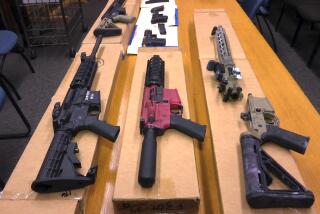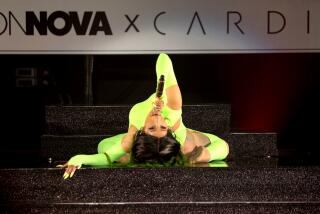‘Knockoff’ Makers Now in Style
- Share via
Come Sunday night, Los Angeles apparel maker Allen Schwartz will be watching the Academy Awards from his living room with five employees who will quickly make sketches as stars step from their limos. At 6 a.m. Monday, Schwartz’s company, A.B.S., will begin making patterns.
“By 2 in the afternoon, you’ll actually start seeing those dresses being born,” he said.
Schwartz makes look-alike designer clothes--and he’s one of many in the “knockoff” trade who may benefit from the Supreme Court’s unanimous decision this week.
The high court ruled that dresses, shoes, golf clubs and other products that simply copy the distinctive look of famous brands do not violate trademark protection rules. It said protection applies only when designers can show that customers might be tricked into thinking they were buying the brand-name item.
The ruling was based on a case involving Wal-Mart Stores Inc., which had undercut retail competitors by selling seersucker outfits that were copies of distinctive designs of another garment maker.
As people like Schwartz see it, the court’s edict is likely to embolden more companies to copy designer fashions and sell their products to discount and mid-level department stores where the bargain hunters shop, such as Wal-Mart and Mervyn’s.
The ruling “could encourage more private-label manufacturing by retailers, which is already growing by leaps and bounds,” said Joe Rodriguez, executive director of the Garment Contractors Assn. of Southern California. “This kind of opens the doors to more of that.”
Rodriguez said companies that sell to such discount and mid-level department stores as Target, Wal-Mart and J.C. Penney Co. stand to gain the most from the high court’s decision.
But others don’t see the court’s decision resulting in a flood of additional knockoffs, simply because there is already an abundance of those goods in the marketplace.
“All this ruling means is that it’s business as usual,” said Ilse Metchek, executive director of the California Fashion Assn., a trade group in Los Angeles. “There are companies that pride themselves on giving girls prom dresses they see on the Academy Awards. That’s the way the industry’s always been.”
“This case strongly reaffirms the right to copy and does so unambiguously and in a brief and forceful opinion,” said John Shepard Wiley Jr., a professor of law at UCLA Law School. “So the great American tradition of knockoffs will continue.”
Analysts say, however, that makers of some brand-name products, especially “simple consumer” items such as pencils, are more vulnerable. They could lose out to more knockoffs because they can be easily and quickly copied.
For some original designers, they may try to blunt the potential increase in imitation goods by moving to patent or copyright their products earlier.
Because such things as logos, packaging and graphics can obtain copyright or trademark protection, manufacturers are likely to “add some bells and whistles” on their athletic shoes, golf clubs and the like to protect their products from knockoffs, said Neil Netanel, a professor at the University of Texas Law School.
The Supreme Court’s ruling did not encompass counterfeit goods, which are illegal. Nor did it involve copyrights or patents. But Justice Antonin Scalia did say judges should be cautious about letting manufacturers bring lawsuits based on trademark claims and should reject claims of protection unless designers can show that consumers were duped.
An attorney for sunglass maker Oakley Inc., which has waged war against counterfeiters, said he doesn’t think this latest court decision will faze the Foothill Ranch company, because it has patents and trademarks on all of its products.
Neither did the court’s decision disturb Callaway Golf Co., which also vigorously protects its products.
“It will have no impact on us because the other areas of protection, including copyright, design patents, utility patents and trademarks remain unchanged,” said Steve McCracken, Callaway’s executive vice president and chief legal officer.
William Fisher, a professor at Harvard University Law School, said he thinks the court’s ruling will have limited impact. Despite the high court’s decision, manufacturers of products with well-recognized designs will still enjoy trademark protection.
“The design of a product is shielded by trademark law if consumers have come to associate a product’s shape with a specific manufacturer,” Fisher said. “So if the shape of a Ferrari is strongly associated with a particular manufacturer, in this case Ferrari, it is protected.”
The shape and bright colors of Apple Computer’s iMac are also likely to be protected, he added.
“This was just one arrow in quite a substantial quiver of legal devices available to the designers of consumer products,” Fisher said. “The ruling just cuts back in a single area. I think the net effect will be small.”
More to Read
Inside the business of entertainment
The Wide Shot brings you news, analysis and insights on everything from streaming wars to production — and what it all means for the future.
You may occasionally receive promotional content from the Los Angeles Times.










